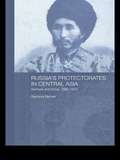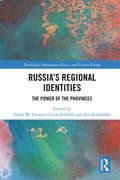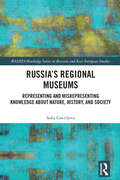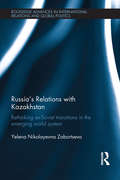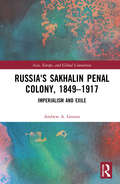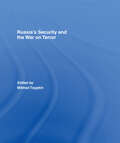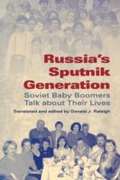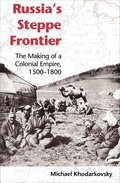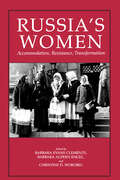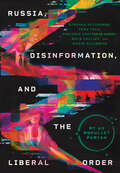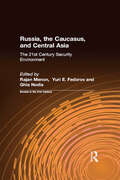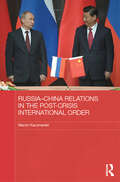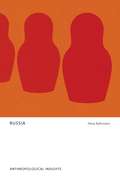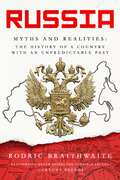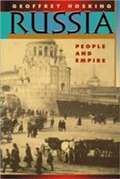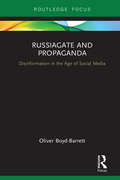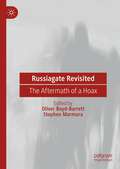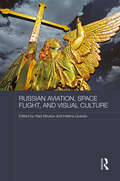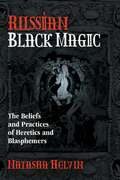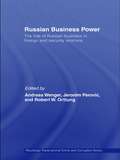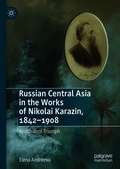- Table View
- List View
Russia's Protectorates in Central Asia: Bukhara and Khiva, 1865-1924 (Central Asian Studies #No. 54)
by Seymour BeckerThis book examines the Russian conquest of the ancient Central Asian khanates of Bukhara and Khiva in the 1860s and 1870s, and the relationship between Russia and the territories until their extinction as political entities in 1924. It shows how Russia's approach developed from one of non-intervention, with the primary aim of preventing British expansion from India into the region, to one of increasing intervention as trade and Russian settlement grew. It goes on to discuss the role of Bukhara and Khiva in the First World War and the Russian Revolution, and how the region was fundamentally changed following the Bolshevik conquest in 1919-20.The book is a re-issue of a highly regarded classic originally published in 1968 and out of print for some years. The new version includes a new introduction, some corrections of errors, and a survey of new work undertaken since first publication.
Russia's Regional Identities: The Power of the Provinces (Routledge Contemporary Russia and Eastern Europe Series)
by Ani Kokobobo Edith W. Clowes Gisela ErbslöhContemporary Russia is often viewed as a centralised regime based in Moscow, with dependent provinces, made subservient by Putin’s policies limiting regional autonomy. This book, however, demonstrates that beyond this largely political view, by looking at Russia’s regions more in cultural and social terms, a quite different picture emerges, of a Russia rich in variety, with different regional identities, cultures, traditions and memories. The book explores how identities are formed and rethought in contemporary Russia, and outlines the nature of particular regional identities, from Siberia and the Urals to southern Russia, from the Russian heartland to the non-Russian republics.
Russia's Regional Museums: Representing and Misrepresenting Knowledge about Nature, History and Society (BASEES/Routledge Series on Russian and East European Studies)
by Sofia GavrilovaThis book presents the results of extensive research into the very interesting phenomenon of local museums—kraevedschskyi museums—in Russia’s regions. It outlines how numerous such museums are, how long they have existed, what they display, and how this has changed, or not, from Soviet times up to the present. It shows how the museums’ displays often are about nature, history, and society. It goes on to discuss how what is portrayed represents particular interpretations of knowledge— including the heroism of the Soviet past, a colonial-style view of Russia’s very many non-Russian people, and the failure to mention things which might present Russia in a critical way. The book is much more than ‘museum studies’: it sheds a great deal of light on how Russians think about themselves and about how this self-view is fostered, and it also highlights the vast regional differences which exist in Russia.
Russia's Relations with Kazakhstan: Rethinking Ex-Soviet Transitions in the Emerging World System (Routledge Advances in International Relations and Global Politics)
by Yelena Nikolayevna ZabortsevaRecent political developments in post-Soviet countries have raised novel issues regarding the stability of the post-Cold War world order. A new direction in policy has been exemplified by the recent bolstering of a number of post-Soviet political and economic institutions - such as CSTO, SCO and the Eurasian Economic Union - in which the role of Kazakhstan is considerable. In addition to its unique geopolitical location, Kazakhstan’s importance in regional integration structures and international relations more broadly is reinforced by its rich oil and uranium deposits. This book centres on an exploration of the changing relations between Russia and Kazakhstan and their impact on post-Soviet interactions with the rest of the world. The role of specific factors in the formation of the post-Soviet regional system will be explored in historical perspective. The multifaceted relations between Kazakhstan and Russia from 1991 to the contemporary period will be analysed in terms of relations in several spheres: political, military and security, Kazakhstan’s nuclear withdrawal, ethnicity and national identity, economic, foreign policies, regionalism and international trends and the impact of historic trends. An important analysis of Kazakhstan, the second largest country in the post-Soviet world, this book is of interest to researchers of International Relations, Post-Soviet Studies and Central Asia Studies.
Russia's Sakhalin Penal Colony, 1849–1917: Imperialism and Exile (Asia, Europe, and Global Connections)
by Andrew A. GentesThis book provides a comprehensive history of the genesis, existence, and demise of Imperial Russia’s largest penal colony, made famous by Chekhov in a book written following his visit there in 1890. Based on extensive original research in archival documents, published reports, and memoirs, the book is also a social history of the late imperial bureaucracy and of the subaltern society of criminals and exiles; an examination of the tsarist state’s failed efforts at reform; an exploration of Russian imperialism in East Asia and Russia’s acquisition of Sakhalin Island in the face of competition from Japan; and an anthropological and literary study of the Sakhalin landscape and its associated values and ideologies. The Sakhalin penal colony became one of the largest penal colonies in history. The book’s conclusion prompts important questions about contemporary prisons and their relationship to state and society.
Russia's Security and the War on Terror
by Mikhail TsypkinThis book discusses and provides examples of Russia‘s need to reshape its security and military policies in order to meet the global challenges of fighting terrorism and counterinsurgency. It addresses some of the problems facing Russia‘s national security and military power, including:military reformUS-Russian relationsthe political economy of Rus
Russia's Skinheads: Exploring and Rethinking Subcultural Lives (Routledge Contemporary Russia and Eastern Europe Series)
by Hilary Pilkington Al'bina Garifzianova Elena Omel'chenkoRussia’s Skinheads: Exploring and Rethinking Subcultural Lives provides a thorough examination of the phenomenon of skinheads, explaining its nature and its significance, and assessing how far Russian skinhead subculture is the ‘lumpen’ end of the extreme nationalist ideological spectrum. There are large numbers of skinheads in Russia, responsible for a significant number of xenophobic attacks, including 97 deaths in 2008 alone, making this book relevant to Russian specialists as well as to sociologists of youth subculture. It provides a practical example of how to investigate youth subculture in depth over an extended period – in this case through empirical research following a specific group over six years – and goes on to argue that Russian skinhead subculture is not a direct import from the West, and that youth cultural practices should not be reduced to expressions of consumer choice. It presents an understanding of the Russian skinhead as a product of individuals’ whole, and evolving, lives, and thereby compels sociologists to rethink how they conceive the nature of subcultures.
Russia's Sputnik Generation: Soviet Baby Boomers Talk About Their Lives
by Donald J. RaleighRussia's Sputnik Generation presents the life stories of eight 1967 graduates of School No. 42 in the Russian city of Saratov. Born in 1949/50, these four men and four women belong to the first generation conceived during the Soviet Union's return to "normality" following World War II. Well educated, articulate, and loosely networked even today, they were first-graders the year the USSR launched Sputnik, and grew up in a country that increasingly distanced itself from the excesses of Stalinism. Reaching middle age during the Gorbachev Revolution, they negotiated the transition to a Russian-style market economy and remain active, productive members of society in Russia and the diaspora. <p><p> In candid interviews with Donald J. Raleigh, these Soviet "baby boomers" talk about the historical times in which they grew up, but also about their everyday experiences--their family backgrounds; childhood pastimes; favorite books, movies, and music; and influential people in their lives. These personal testimonies shed valuable light on Soviet childhood and adolescence, on the reasons and course of perestroika, and on the wrenching transition that has taken place since the collapse of the Soviet Union in 1991.
Russia's Steppe Frontier: The Making of a Colonial Empire, 1500-1800 (Indiana-Michigan Series in Russian and East European Studies)
by Michael KhodarkovskyThis study of Russia&’s colonial expansion across the Eurasian steppe is &“a tremendously important contribution to the field of Russian history&” (Valerie Kivelson).From the decline of the Mongol Golden Horde to the end of the 18th century, the Russian government expanded its influence and power throughout its southern borderlands. The process of incorporating these lands and peoples into the Russian Empire was not only a military and political struggle but also a cultural contest between the indigenous worlds of the steppe and Russian imperial hegemony. Drawing on sources and archival materials in Russian and Turkic languages, Michael Khodarkovsky presents a complex picture of the encounter between the Russian authorities and native peoples. A major contribution to the comparative study of empires and frontiers, &“no other work treats Moscow's colonial expansion to the south and east so competently&” (Russia).
Russia's Women: Accommodation, Resistance, Transformation
by Barbara Evans Clements Barbara Alpern Engel Christine D. WorobecBy ignoring gender issues, historians have failed to understand how efforts to control women—and women's reactions to these efforts—have shaped political and social institutions and thus influenced the course of Russian and Soviet history. These original essays challenge a host of traditional assumptions by integrating women into the Russian past. Using recent advances in the study of gender, the family, class, and the status of women, the authors examine various roles of Russian women and offer a broad overview of a vibrant and growing field.
Russia, Disinformation, and the Liberal Order: RT as Populist Pariah (NIU Series in Slavic, East European, and Eurasian Studies)
by Stephen Hutchings Marie Gillespie Vera Tolz Rhys Crilley Precious Chatterje-DoodyThrough the prism of the first comprehensive account of RT, the Kremlin's primary tool of foreign propaganda, Russia, Disinformation and the Liberal Order sheds new light on the provenance and nature of disinformation's threat to democracy. Interrogating the communications strategies pursued by authoritarian states and grassroots populist movements, the book reveals the interlinked nature of today's global media-politics pathologies.Stephen Hutchings, Vera Tolz, Precious Chatterje-Doody, Rhys Crilley, and Marie Gillespie provide a systematic investigation into RT's history, institutional culture, and journalistic ethos; its activities across multiple languages and media platforms; its audience-targeting strategies and audiences' engagements with it; and its response to the war in Ukraine and associated bans on the network. The authors' analysis challenges commonplace notions of disinformation as something that Russia brings to the West, where passive publics are duped by the Kremlin's communications machine, and reveals the reciprocal processes through which Russia and disinformation infiltrate and challenge the liberal order. Russia, Disinformation and the Liberal Order provides provocative insights into the nature and extent of the challenge that Russia's propaganda operation poses to the West. The authors contend that the challenge will be met only if liberals reflect on liberalism's own internal tensions and blind spots and defend the values of open-minded impartiality.
Russia, the Caucasus, and Central Asia (Eurasia In The 21st Century Ser. #Vol. 2)
by Rajan Menon Yuri E. Fedorov Ghia Nodia East West InsituteThis comprehensive exploration of the international environment examines not only traditional political-military concerns but also economic, ethnic, and environmental issues and the role of crime, terrorism, the drug trade, and migration in the security environment of Russia and its neighbours to the south. This approach takes account of both the internal and external aspects of security problems and their interplay. The participation of international authors facilitates the consideration of each problem from all relevant points of view.
Russia-China Relations in the Post-Crisis International Order (BASEES/Routledge Series on Russian and East European Studies)
by Marcin KaczmarskiThe book explores developments in Russia-China relations in the aftermath of the global economic crisis, arguing that the crisis transformed their bilateral affairs, regional liaisons and, crucially, altered the roles both states play on the international arena. Discussing how Russo-Chinese cooperation has accelerated in energy trade, arms sales and in the Russian Far East, the focus is on how the still mutually advantageous relationship has become more asymmetric than ever, reflecting China’s meteoric rise and Russia’s decline. These dynamics are explored through three perspectives: domestic, regional and global. Domestically, the book traces the role of political coalitions and key interest groups involved in how the two states shape their reciprocal policies. Changes in the regional dimension are examined with particular reference to a new status quo emerging in Central Asia. The book concludes by explaining how the changing relationship is affecting the international order, including the balance of power vis-à-vis the United States as well as Russia and China’s changing attitudes towards global governance.
Russia-Iran Relations Since the End of the Cold War (Durham Modern Middle East and Islamic World Series)
by Eric D. MooreThis book presents a comprehensive, systematic analysis of Russia– Iran relations in the period following the collapse of the Soviet Union in 1991. It discusses the key areas – such as trade, arms sales, nuclear developments, and potential areas of friction in the Caspian Sea – where co-operation is possible; charts different phases of increasing and declining co-operation; and relates these changes to security considerations and domestic factors in both countries. Throughout, the book argues that the potential for co-operation between the two countries is much greater than people realize, and it concludes by assessing how Russia–Iran relations are likely to develop in future.
Russia: Anthropological Insights (Anthropological Insights)
by Petra RethmannThis book offers a brief introduction to the anthropological study of Russia. Moving beyond the conceptual iron curtain that has divided past study of Russia into "East" and "West," it situates Russia in a global context and provides readers with all of the necessary analytical tools for understanding the complex cultural and social configurations of the contemporary Russian Federation. Based on extensive fieldwork in Russia, it offers unique insights into a number of cultural configurations—including socialism, violence, mythology, colonialism, nationalism, gender, memory, democracy, media, and art. Through the use of interesting case studies and ethnographic "snapshots," the author has produced a lively and engaging overview of Russia’s cultural meaning and significance.
Russia: Myths and Realities
by Roderick BraithwaiteAn expert historian and former ambassador to Moscow unlocks fact from fiction to reveal what lies at the root of the Russian story.Churchill remarked that Russia is a riddle wrapped in a mystery inside an enigma. That has become an excuse for intellectual laziness. Russia is not all that different from anywhere else. But you have to disentangle the facts from the myths created both by the Russians themselves and by those who dislike them. In this dynamic new history, Rodric Braithwaite—Russia expert and former ambassador to Moscow—does exactly that, unpicking fact from fiction to discover what lies at the root of the Russian story. Russia is the largest country in the world, with the largest arsenal of nuclear weapons. Over a thousand years this multifaceted nation of shifting borders has been known as Rus, Muscovy, the Russian Empire, and the Soviet Union. Thirty years ago it was reinvented as the Russian Federation. Like the rest of us, the Russians constantly rewrite their history. They, too, omit episodes of national disgrace in favor of patriotic anecdotes, sometimes more rooted in myth than reality. Russia is not an enigma, but its past is violent, tragic, sometimes glorious, and always complicated.
Russia: People and Empire, 1552-1917
by Geoffrey HoskingThe Soviet Union crumbles and Russia rises from the rubble, once again the great nation--a perfect scenario, but for one point: Russia was never a nation. And this, says the eminent historian Geoffrey Hosking, is at the heart of the Russians' dilemma today, as they grapple with the rudiments of nationhood. His book is about the Russia that never was, a three-hundred-year history of empire building at the expense of national identity. Russia begins in the sixteenth century, with the inception of one of the most extensive and diverse empires in history. Hosking shows how this undertaking, the effort of conquering, defending, and administering such a huge mixture of territories and peoples, exhausted the productive powers of the common people and enfeebled their civic institutions. Neither church nor state was able to project an image of "Russian-ness" that could unite elites and masses in a consciousness of belonging to the same nation. Hosking depicts two Russias, that of the gentry and of the peasantry, and reveals how the gap between them, widened by the Tsarist state's repudiation of the Orthodox messianic myth, continued to grow throughout the eighteenth and nineteenth centuries. Here we see how this myth, on which the empire was originally based, returned centuries later in the form of the revolutionary movement, which eventually swept away the Tsarist Empire but replaced it with an even more universalist one. Hosking concludes his story in 1917, but shows how the conflict he describes continues to affect Russia right up to the present day.
RussiaGate and Propaganda: Disinformation in the Age of Social Media
by Oliver Boyd-BarrettThis book furthers our understanding of the practice of propaganda with a specific focus on the RussiaGate case. RussiaGate is a discourse about alleged Russian "meddling" in US elections, and this book argues that it functions as disinformation or distraction. The book provides a framework for better understanding of ongoing developments of RussiaGate, linking these to macroconsiderations that rarely enter mainstream accounts. It demonstrates the considerable weaknesses of many of the charges that have been made against Russia by US investigators, and argues that this discourse fails to take account of broader non-transparent persuasion campaigns operating in the election-information environment that are strengthened by social media manipulation. RussiaGate has obscured many of the factors that challenge the integrity of democratic process in the USA. These deserve a much higher priority than any influence that Russia may want to exert. The book concludes that RussiaGate discourse needs to be contextualized with reference to a long-established broader competition between great powers for domination of EurAsia. This pitches the US/European Union against Russia/China and perhaps, ultimately, even the USA against Europe. This book will be of much interest to students of media and communication studies, propaganda studies, US politics, Russian politics, and International Relations in general.
Russiagate Revisited: The Aftermath of a Hoax
by Oliver Boyd-Barrett Stephen MarmuraThis volume provides a comprehensive, scholarly re-examination of the events and developments collectively referred to as Russiagate. In 2016 a consensus emerged within American and British intelligence, political, and news media establishments that Russia was interfering in the United States federal election vis-à-vis an “influence campaign,” in support of the candidacy of Donald Trump. This narrative monopolized western media attention for over five years but has proven poorly founded in fact. Russiagate Revisited examines the authenticity of official Russiagate claims, the role of mainstream and alternative media as both observers of and participants in the drama, what Russiagate reveals about the state of mainstream journalism, the gambits of professional propagandists within a long-established campaign of demonization of Russia, how Russiagate narratives were perceived in Russia, and the grave implications - of both Russiagate and the decline of trust in public information - for sustainable western democracy.
Russian Aviation, Space Flight and Visual Culture (Routledge Contemporary Russia and Eastern Europe Series)
by Helena Goscilo Vlad StrukovAmong the many successes of the Soviet Union were inaugural space flight—ahead of the United States—and many other triumphs related to aviation. Aviators and cosmonauts enjoyed heroic status in the Soviet Union, and provided supports of the Soviet project with iconic figures which could be used to bolster the regime’s visions, self-confidence, and the image of itself as forward looking and futuristic. This book explores how the themes of aviation and space flight have been depicted in film, animation, art, architecture, and digital media. Incorporating many illustrations, the book covers a wide range of subjects, including the representations of heroes, the construction of myths, and the relationship between visual art forms and Soviet/Russian culture and society.
Russian Black Magic: The Beliefs and Practices of Heretics and Blasphemers
by Natasha HelvinA rare look into the history, theory, and craft of the black mages and sorcerers of Russia • Examines practical rituals and spells, the demonic pantheon, places of power, offerings and sacrifices, Hell Icons, and instructions for cemetery magic • Provides insight into the fundamental ideology of black magic practitioners, from the universal laws of magic to the principles of morality • Details how the Russian practice of black magic preserved ancient pagan traditions and evolved as the antithesis of Christianity Born in the Soviet Union and descended from a matrilineal line of witches, Natasha Helvin offers a rare look into the secret practices of Russian black magic, passed down from teacher to disciple for generations both orally and through their grimoires bound in black. Drawing from her own experience, Helvin provides insight into the fundamental ideology of black magic practitioners, from the universal laws of magic to the principles of morality. She explains a mage’s view on fate and predestination, how the world was created, and their relationship with the demons that grant them their power. She examines the demonic pantheon as well as how a black sorcerer is able to influence the forces in the universe and pass on his or her powers and knowledge to further generations. Exploring the history of occult practices in Russia, including how Christianity had a profound effect upon magic and witchcraft, Helvin shows how attempts to forcibly convert the Russian population to the Christian faith were widely resisted, and instead of these ancient pagan practices disappearing, they blended with Christian belief. Authorities repainted old pagan gods as demons in order to eradicate ancient traditions. Black magic became labelled as defiantly anti-Christian simply for preserving the old ways, and as a result, some branches of black magic evolved as a reaction against enforced Christianity and practitioners proudly accepted the label of “blasphemer” or “heretic.” Through this book, readers can explore the Left-Hand path of Russian magic and its spells and rituals. The author explains about cemetery magic, sacrifices, the creation of Hell Icons, and places of power, such as crossroads, swamps, and abandoned villages, as well as the best times to practice black magic, how to choose the best grave for your spell, and how to summon demons. Providing many concrete examples of spells, Helvin demonstrates the broad range of what can be accomplished by those who practice the black arts, if they commit themselves to the craft.
Russian Business Power: The Role of Russian Business in Foreign and Security Relations (Routledge Transnational Crime and Corruption)
by Andreas Wenger Jeronim Perović Robert W. OrttungSince the collapse of the Soviet Union, Russia has developed a powerful business community and a potent network of transnational organized groups. Russian Business Power explores the powerful impact these new actors are having on the evolution of the Russian state and its foreign behaviour. Unlike other books, which focus either on Russia's foreign and security policy, or on the evolution of Russian business, legal and illegal, within the context of Russia's domestic transition, this book considers how far Russia's foreign and security policy is shaped by business. It considers a wide range of issues, including energy, the arms trade, international drug flows, and human trafficking, and examines the impact of Russian business in Russia's dealings with Western and Eastern Europe, the Caspian, the Caucasus and the Far East.
Russian Central Asia in the Works of Nikolai Karazin, 1842–1908: Ambivalent Triumph
by Elena Andreeva“This book provides a deep reading of Nikolai Karazin’s works and his relationship with Central Asia. Elena Andreeva shows how Karazin’s prolific creations have much to tell us about Russian imperialism, colonial and local society as well as Russians’ self-identity as colonizers and Europeans. The work offers an original contribution to the scholarship on Russian imperial history and that of Central Asia, and Russian literary history also. Karazin’s importance—at the time and now—is appropriately highlighted.” - Jeff Sahadeo, Associate Professor, Carleton University, Canada “Elena Andreeva’s book resurrects a vital if forgotten figure from the Russian past: Nikolai Karazin, Russia’s Kipling, a multifaceted participant in Russian imperial expansion, whose fiction, journalism, ethnography and visual representations may well have done more than any agent of the Russian state to represent and popularize Russia’s conquest of Central Asia to a newly literate Russian public beyond the educated elites. Archivally based and carefully argued, Andreeva’s study of Karazin reveals the absence of any singular logic to Russian imperial expansion. In her analysis Karazin emerges as a vernacular enthusiast of empire who was able to reconcile a skeptical attitude towards tsarist autocracy with an idealized view of Russia’s 'civilizing' mission in the East.” - Harsha Ram, Associate Professor, University of California, Berkeley, USA This book is dedicated to the literary and visual images of Central Asia in the works of the popular Russian artist Nikolai Karazin. It analyzes the ways Karazin’s discourse inflected, and was inflected by, the expansion of the Russian empire – and therefore sheds light on the place of art and culture in the Russian colonial enterprise. It is the first attempt to interpret Karazin’s images of Central Asia within Russian imperial networks and within the maze of the Russian national identity that informed them.
Russian Cinema (Inside Film)
by David C. GillespieRussian Cinema provides a lively and informative exploration of the film genres that developed during Russia's tumultuous history, with discussion of the work of Eisenstein, Pudovkin, Mikhalkov, Paradzhanov, Sokurov and others. The background section assesses the contribution of visual art and music, especially the work of the composers Shostakovich and Prokofev, to Russian cinema. Subsequent chapters explore a variety of topics: The literary space - the cinematic rendering of the literary text, from 'Sovietized' versions to bolder and more innovative interpretations, as well as adaptations of foreign classics The Russian film comedy looks at this perennially popular genre over the decades, from the 'domestication' of laughter under Stalin to the emergence of satire The historical film - how history has been used in film to affirm prevailing ideological norms, from October to Taurus Women and Russian film discusses some of the female stars of the Soviet screen (Liubov Orlova, Vera Alentova, Liudmila Gurchenko), as well as films made by male and female directors, such as Askoldov and Kira Muratova Film and ideology shows why ideology was an essential component of Soviet films such as The Maxim Trilogy, and how it was later definitively rejected The Russian war film looks at Civil War and Second World War films, and the post-Soviet treatment of recent conflicts in Afghanistan and Chechnya Private life and public morality explores the evolution of melodramas about youth angst, town and village life, personal relationships, and the emergence of the dominant sub-genre of the 1990s, the gangster thriller Autobiography, memory and identity offers a close reading of the work of Andrei Tarkovskii, Russia's greatest post-war director, whose films, including Andrei Rublev and Mirror, place him among the foremost European auteur film-makers Russian Cinema offers a close analysis of over 300 films illustrated with representative stills throughout. As with other titles in the Inside Film series it includes comprehensive filmographies, a thorough bibliography and an annotated further reading list. The book is a jargon-free, accessible study that will be of interest to undergraduates of film studies, modern languages, Russian language and literature, as well as cineastes, film teachers and researchers.
Russian Citizenship: From Empire To Soviet Union
by Eric LohrRussian Citizenship is the first book to trace the Russian state’s citizenship policy throughout its history. Focusing on the period from the mid-nineteenth century to the consolidation of Stalin’s power in the 1930s, Eric Lohr considers whom the state counted among its citizens and whom it took pains to exclude. His research reveals that the Russian attitude toward citizenship was less xenophobic and isolationist and more similar to European attitudes than has been previously thought-until the drive toward autarky after 1914 eventually sealed the state off and set it apart. Drawing on untapped sources in the Russian police and foreign affairs archives, Lohr’s research is grounded in case studies of immigration, emigration, naturalization, and loss of citizenship among individuals and groups, including Jews, Muslims, Germans, and other minority populations. Lohr explores how reform of citizenship laws in the 1860s encouraged foreigners to immigrate and conduct business in Russia. For the next half century, citizenship policy was driven by attempts to modernize Russia through intensifying its interaction with the outside world. But growing suspicion toward non-Russian minorities, particularly Jews, led to a reversal of this openness during the First World War and to a Soviet regime that deprived whole categories of inhabitants of their citizenship rights. Lohr sees these Soviet policies as dramatically divergent from longstanding Russian traditions and suggests that in order to understand the citizenship dilemmas Russia faces today-including how to manage an influx of Chinese laborers in Siberia-we must return to pre-Stalin history.
